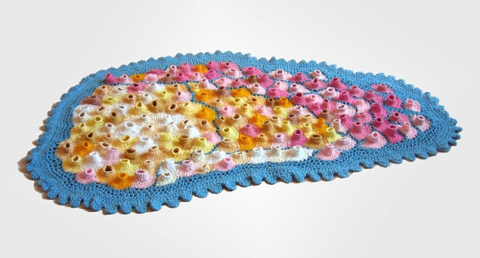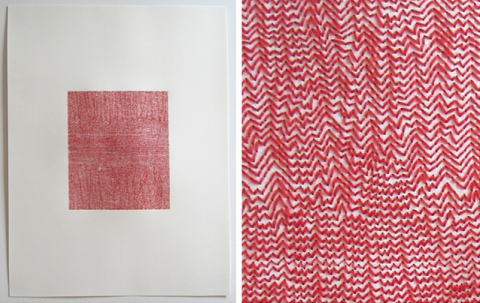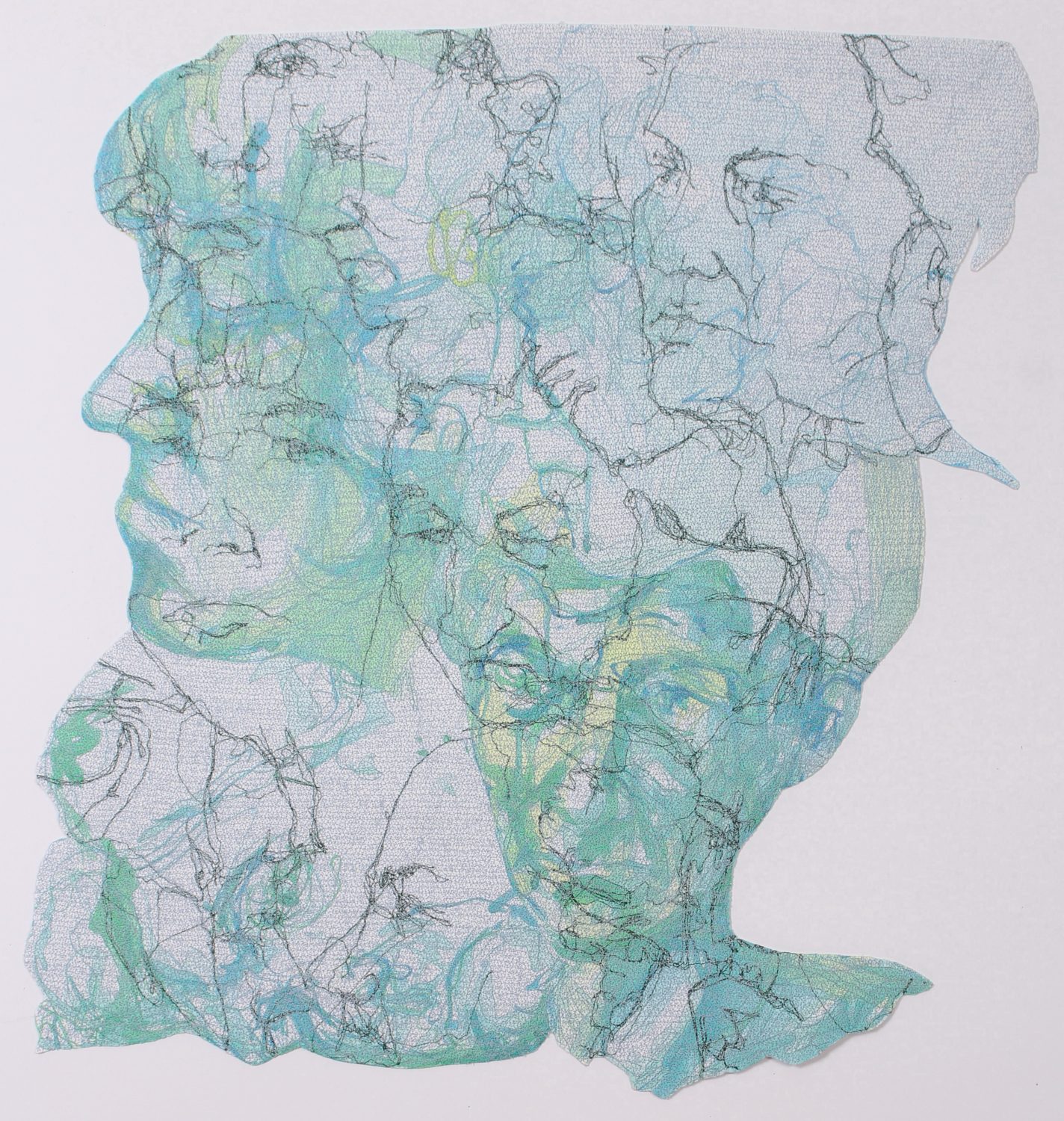I came across the work of Emily Barletta a long time ago when I first started writing my blog. We ended up becoming “blog friends” both reading each others blogs and commenting back and forth. I loved her work and totally respected the time and discipline it took to complete each piece. Then one day at a birthday party a nice and quiet woman asked me “are you little yellow bird?” and as my very first moment of someone knowing my “voice” before they knew me I met her. Since both Emily and I live in Brooklyn we have been lucky enough to cross paths a number of times, exhibit many times together, and I had the privilege of curating her work into one of my exhibits.
I continue to be inspired by Emily’s work and feel privileged to have her within my personal arts community. I am delighted to share her interview. Read on.
If you had to describe your work in 3 words what would they be?
Red. Slow. Hand.
What is your background as an artist?
I went to the Maryland Institute College of Art and received my BFA in fibers. While I was there I tried many different mediums, photography, painting, metal fabrication, and screen-printing were of interest, but weaving, embroidery and machine knitting ended up being my favorite. I spent most of my childhood cross-stitching, crocheting blankets, beading, and doing all sorts of craft projects. It wasn’t until taking an intro to fibers class in college that I realized these techniques could be applied toward making art.
You work in a number of different techniques can you talk about the roles of the different materials and processes? How do you decide in which technique to work (i.e. crochet, embroidery,)
Usually when I’m planning to make something, it begins as a visual image, without the form of materials yet, and then I have to decide what material and technique to impose on it. This is the hard part for me. When I think about using embroidery it is not only about covering a surface, but I also have to decide what surface to use. Whereas crochet has always been a more sculptural medium, I use it to build form and surface and then there is nothing to cover. I have always felt limited by these two constraints and have tried to combine them, but without success. I also tend to think about what size I want the work to be, crochet can be larger whereas embroidery tends to stay small. In attempts to make embroidery works larger, I started accumulating multiple objects that are displayed together as one large piece, like my pieces birds, or scabs, or most recently untitled (rocks).
How does working with fiber and craft affect the conceptual aspect of your work?
It doesn’t. It just happens to be what works for me. I have to enjoy what I’m working on or I will not work on it any more. This is the only process that I have found truly enjoyable. It is relaxing. I can do it while sitting on a couch. It’s not messy. I also tend to think of it like drawing and mark making and this satisfies me.
Many of your past works actually are small individual items in mass, what is the intention behind this style of working?
At the time I was making those works, they worked well with my lifestyle. I could make them anywhere because each shape was usually smaller than my hand and I was very interested in working fast. I could make them in a small amount of time so it would keep my attention and I wouldn’t get distracted. Also there wasn’t much thinking involved beyond the original intent. I like to have most of the decisions made in advance so that I don’t have to think too much while I’m working. Also I didn’t need a large studio to make this work and I didn’t need to make the work at home (I could do it in a park or coffee shop or on the subway.
I know that you suffer from a spinal disease, how does this affect your work both conceptually and in practice of making?
At art school I was encouraged to make art from a deeply personal and meaningful place, and for me this meant making art that explored my feelings about my health problems. Over time my conceptual ideas have developed and changed. They are less specifically about my body’s inadequacies and more vaguely about counting time passing, and abstract pattern growth. Now I think about my artwork as a more vague expression of everything I am experiencing in my day to day. It has moved away from an expression of a specific pain, but it is still there for me when I need it that way.
It seems that your work often references growths and cellular structures but due to the attention to detail, meticulousness of your hand, and color choices it also stays in a place that is very “beautiful” is this intentional?
It’s not intentional. It’s a fight. I always try to make something that looks as though it came into existence by natural means. I don’t want to force materials to make marks they don’t naturally make or form shapes that feel intuitively unnatural. Before each thing is made, I imagine it as a sort of chaos explosion and through making it I am enforcing order into the situation, pinning ideas down and forcing them to take shape, while trying to maintain my original chaos idea. And these two ideas struggle with what the materials want to do, and with what I want to do, and usually order takes over and wins. I think that’s what you are referring to when you say beautiful, for me it is control and order.
Your color choices inform the experience of the work very much. Can you discuss how you make color choices and how you use color as an artist?
For years now, red has been the only color that makes sense for me. Any other color in an artwork is secondary. Usually if the object I’m making is red, then other colors present denote a secondary object or idea invading into the art, like a problem or a disease. I also have a creeping preoccupation with landscape that sneaks in occasionally to inform the colors. Struggling with form and marks is a challenge enough, and presents a multitude of options. Sticking to one color, especially with my new drawings (works on paper) keeps me focused.
What do you struggle with most as an artist?
Time. Making the time, finding the time, using the time wisely. I work 4 days a week at my job and all I really want to do is sit down and sew when I get home, but I also want to stare at the wall, cook dinner, go out and see things, and spend time with my friends and family. It’s hard to find balance. I don’t find it all that often.
Your newest works are very different from your previous works; they are all red thread on white paper, small-scale, and lack the sculptural elements seen before, they also seem more abstract to me and less referential to the body, can you talk about this new direction for you and what inspired it?
I have often felt limited by fiber materials and have struggled to find the next best material or technique to try. Each piece of art has been an attempt to fix the problems I had with the one before it. One of my ongoing issues with yarn and fabric is that they are soft and pliable, which sounds absurd, but I have always wanted a material that is hard and unbending, while still being able to sew on it or crochet it. It took several years to find a combination of thread and paper that worked.
I spend a lot of time making things that I throw away, often months are lost to the garbage. I have always been very involved with drawing in my sketchbook. I have never been able to find a crossover between my sketchbooks and my ‘art’ that people see. My sketchbooks are a mix of narrative, representational art with patterns imposed over them. Whenever I make art that attempts to mimic this, I am unhappy with it, because I prefer my artwork be evocative and less direct. So with the drawings on paper, I feel that for the first time I am making work that satisfies both my need to draw and my need to sew and the outcome feels like ‘art’ that I want to share with people. As for the size, they are as big as I can comfortably make them and each one can still take several months to complete despite their small size.
How has your work evolved since you first began working with fibers?
I started out weaving in college and I was very committed to it as a medium. After college I couldn’t bring my loom into the tiny Brooklyn bedrooms I was making art in. So out of necessity I started crocheting and embroidering on small objects. Over time I realized that even if I had the space for the loom I didn’t want to go back to it. It requires too much planning and the limitations are very rigid. My original weavings directly referred to the body. I dyed all the yarn myself and I spent hours unwinding and rewinding it into balls in between dye bathes. I remember one piece in particular; I cast my feet hollow in white wax and placed them on the floor below a weaving that was a rectangular size of me, it was white with a red line running through it, only I had cut the weaving into tiny squares and put them all back together encased in wax. There were many things like that. I would weave fabric and cut it up to build sculptures. Over time I think my work has become much more abstract and I am constantly striving to get rid of any unnecessary steps and processes that make it take longer.
What is the next direction or step for your work?
Right now I can’t really see beyond continuing the work on paper. But I am always dreaming about future large-scale crocheted sculptures. They just take so much time, but there are a few waiting to be made.
Describe your studio and studio practice.
Most of my sewing is done while sitting on the couch, but I do have a desk that mostly just gets things piled on it. I make art in my apartment. This is how I like it. I’ve never done well with a studio outside the home. I try to make art daily, on work days I usually get 1-3 hours in after dinner. On a committed studio days I work for as long as I can. I like to watch bad TV shows or listen to books on tape while I work. It’s very relaxing.
You have received some very prestigious grants in the last few years, do you have any advice to other artist who are grant seekers?
I can only say what I have done, which is to apply for everything. And keep applying for everything and not take rejection too seriously. The more I apply the better I think I get at figuring out what works in an application. And I think it’s important to really look at each application and I try to take the time to tailor my materials, images, and writing individually.
It’s hard to say overall, I think they probably change often, but currently I finished reading Just Kids by Patti Smith. It was super inspiring the way she candidly discussed living a life that revolves around the process of making and being creative. Louise Bourgeois is one of my favorite artists. Her art moves me. Sarah Sze could be my third, but you have to see it in person.
What else do you spend your time doing? Do any of these inform your work?
One of my favorite things to do is go see art. I like to go for long walks and sit in parks. I cook lots of yummy vegan food and I like perfecting my recipes. I like listening to nerdy podcasts about science and psychology. I’m currently reading the book Stiff: The Curious Lives of Human Cadavers, by Mary Roach, which most people might find disgusting but I really enjoy things that fall into the realm of disturbing, especially when related to science or psychology and include gory details. Books like this and podcasts might inform the work and definitely give me richly graphic things to think about.
Give us an idea of a day in the life of you.
I go to my job and then I walk a mile and a half slowly home. I like to walk slow. Then I relax, take a bath, bathes are important, and cook dinner. I love spending the whole day planning what I’m going to cook. Then I settle down and make art.
Where can we see your work?
My website emilybarletta.com
My blog emilybarletta.blogspot.com
I will be participating in a group show at Maryland Art Place in Baltimore, MD, curated by Amy Boone-McCreesh (amyboonemccreesh.com) from February 22, 2012 — March 24, 2012.
Thank you so much to Emily for sharing more about her work and I know we all look forward to what she does next.
Until next time keep stitching.
–—
Joetta Maue is a full-time artist, writer, and curator with a focus on the art of the needle. Her most recent body of work is a series of embroideries and images exploring intimacy and the domestic space. Joetta exhibits her work throughout the United States and internationally, and authors the critical blog Little Yellowbird as well as regularly contributes to Mr. X Stitch and the Surface Design Journal.



















